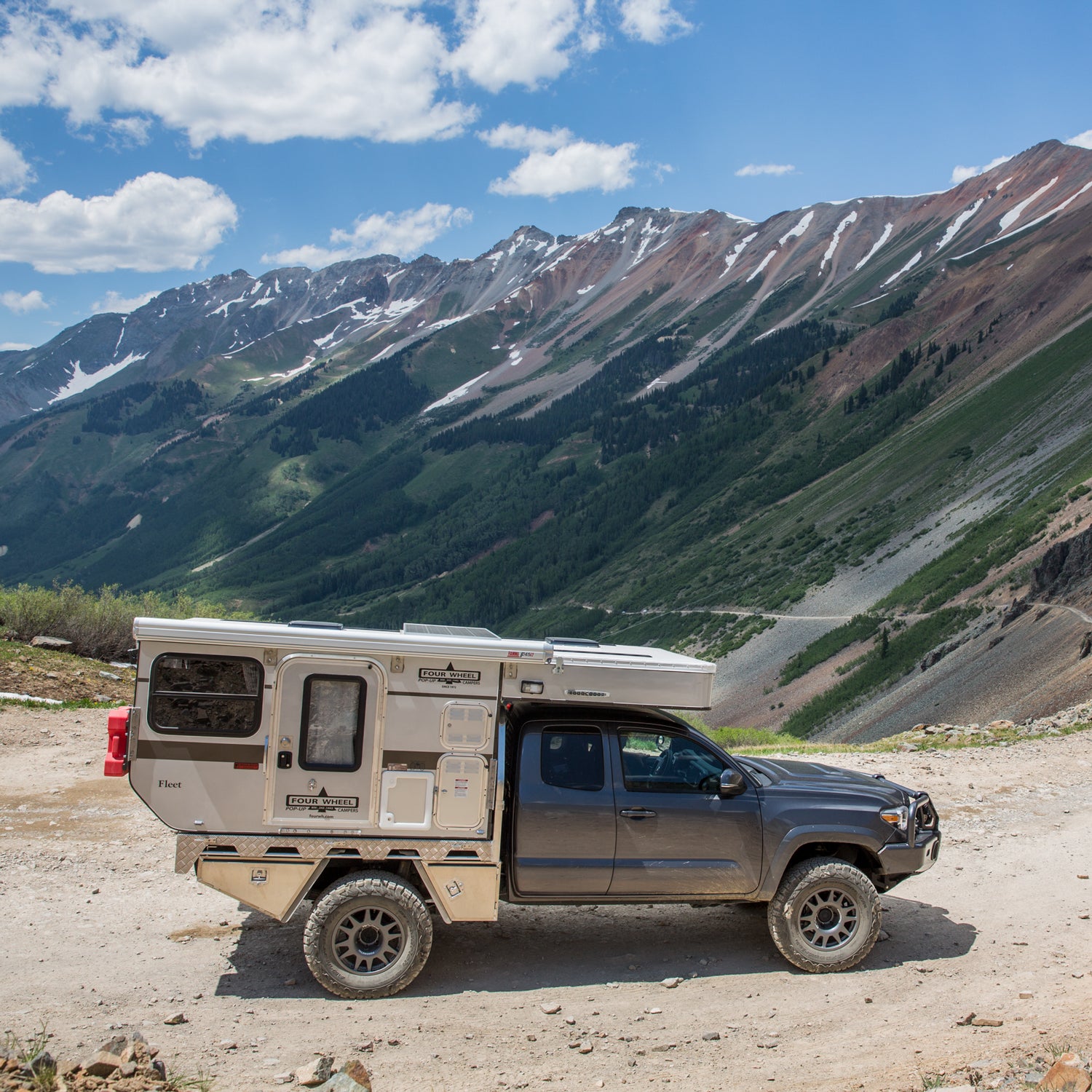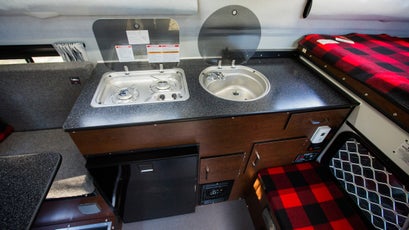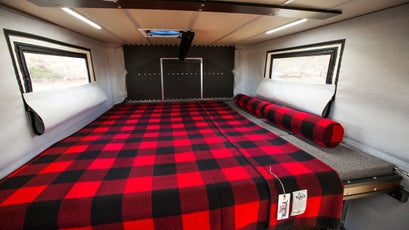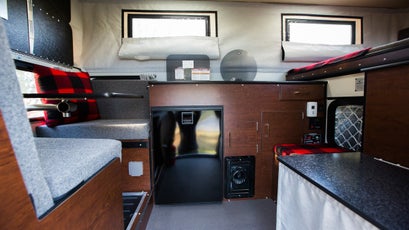Overlanding is sort of like being in a relationship. When you start, you dip your toes and test it out. You buy bigger tires��and maybe a rooftop tent. Then comes true obsession.��This part can take many forms:��For some, it might look like full-time road life. But for others, where road life isn’t possible, it often means a bigger gear investment��to make overlanding more comfortable and convenient.
One of the plushest options for the fully committed is a . These mini homes come with amenities like a refrigerator, toilet, sink, stove, dining table,��heater, inside and outside shower, solar panels, and a queen size bed.��They slide into the back of truck beds or can be attached through a flatbed conversion. They’re called pop-ups because the top third of the camper collapses while you’re traveling to increase aerodynamics and improve vehicle handling, but then pops up once you’re camped to increase headroom.
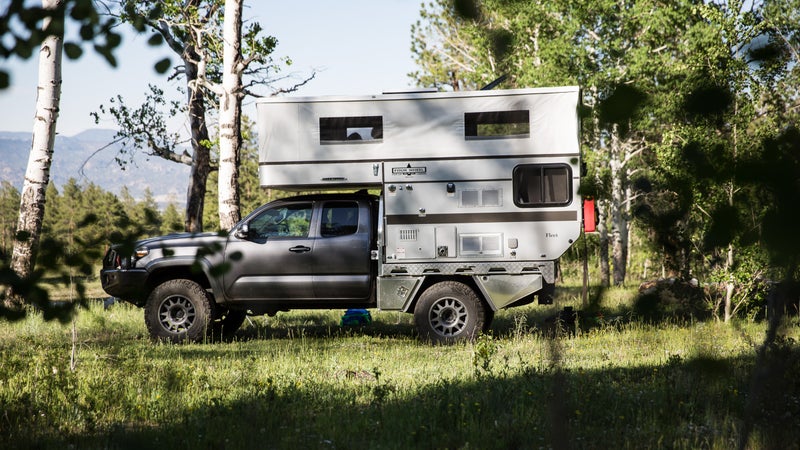
The Four Wheel part of the names refers to the construction. Instead of a wood frame, like you see in some lower-end campers,��these pop-ups come with a sturdy aluminum frame that’s designed to��flex with the bed of your truck as you climb over rocks or through��gullies on your way up a four-wheel-drive road.��The skin of the camper is also made from a rugged aluminum (instead of the more common��fiberglass)��that can take a beating from trees and other obstacles you might encounter.��The pop-top section is made from a vinyl-reinforced��canvas and feels similar��to what you’d find on a raft.��
Four Wheel sells several models, but over the past couple months��I tested the granddaddy of them all: the model, on the back of a 2017 Toyota Tacoma. The flatbed conversion means they took off the normal truck bed��and put a in its place, which gets you a camper with a bigger floor plan at 78��square feet, including the sleeping loft. (You can always put your truck bed back on if you want.)��The reference means that the camper, in addition to all the standard amenities, comes with a bed and seats covered in Woolrich’s 21-ounce��heathered wool upholstery. You also get red and black Buffalo Check blankets and pillows. , based out of West Chester, Pennsylvania, brought Four Wheel and Woolrich together for the collab.
The whole camper setup costs��$52,595. Slapped on the back of my lender��Tacoma, the rig probably cost well over $80,000. This is a lot of money, and��Four Wheel knows it's targeted to a very specific niche—which explains why it only made 100 of these Woolrich models. If you don’t want the Woolrich��edition, you can still get a flatbed for $24,995 (plus $8,600 for the Norweld tray), or a��non-Woolrich slide-in option��(it uses��your existing truck bed) that start at a much more affordable $17,495. Four Wheel also makes��non-Woolrich��bare-bones campers that cost $12,000.
Throughout the test, my family and I put thousands of miles on the truck and spent a couple weeks total living out of this setup. We camped all over southern Colorado and northern New Mexico, including at the top of Ophir Pass, which sits at nearly 12,000 feet between Silverton and Telluride. Here's what we thought.
Ease��of Use
One of the best parts about the��camper is how easy it is to set up. You simply get inside, unhitch a latch, and push the pop-top up, giving you over six feet of head room in under a minute. Some rooftop tents are that easy, but many are not, and require at least 15 or 20 minutes to pitch, thanks to the ladder, rainfly, and window awnings. A couple minutes might not sound like a lot, but it mattered to us when camping with two wild kids who love to run around and get into trouble when we’re not looking.
I also appreciated that��Four Wheel put a lot of thought into how to maximize the floor plan. The camper is packed with amenities and all those amenities worked together seamlessly without any compromises.��For example, a section of the bed slides away to make room for the stove top and sink. You’re not going to be sleeping and cooking at the same time, so it’s a smart use of space. The fridge is conveniently located near the door of��the camper, so it’s easy to access if you want to stop for lunch on the road. And there’s tons of hidden storage under the kitchen table, the bed, etc.��
Those of you who’ve tried to build out your own truck or overlanding��vehicle know that it takes a lot of time to figure out the best organization and storage system. You have drawers, mobile refrigerators, storage bins, etc., and you have to decide how all the gear will fit in your bed and work together. With the Four Wheel, all that work is done for you.��
Amenities
Some of the amenities—like the inside shower—were overkill (we didn’t want to risk getting all that wool wet), but others certainly were not. My favorite pieces were the fridge and high-density foam bed. Four Wheel says the bed is a queen, but it felt bigger. It easily slept my wife and me��and two small kids (a one-��and three-year-old), and at three��inches thick, was almost as comfortable as on our mattress back home. We’ve yet to find a rooftop tent that sleeps all four of us. ��
At 80 liters, the fridge is like the one you had in college and will store plenty of food for a week off the grid.��(There’s also a small freezer that will fit a couple of ice cream bars.) Thanks to a 160-watt solar panel��on top of the camper, the fridge cranked along, and if the sun dipped, there were also two dedicated car batteries to keep it going. Even when temperatures climbed into the nineties on a trip to northern New Mexico, I never worried about my milk going bad. It was actually just the opposite. I had the fridge so cold it froze my vegetables. With some other��mobile fridges, you have to deploy your own panels or��worry about the fridge eating your engine’s battery—concerns that can ruin an otherwise stress-free camping trip.
Additional highlights included two hidden-away ten-gallon propane tanks that ran the two-burner stove for weeks, a hidden 20-gallon water tank that ran the faucet and internal and external shower, an awning, and tons of internal and external lights that also drew from the solar panels. There was a six-gallon water heater for washing dishes and for showers, a propane heater for the winter, and two roof fans to air everything out.
������ٳ��پ�������
During a seven-hour drive to Denver, at least five people rolled past us, made eye contact, and gave us��a thumbs-up. At gas stations, people would constantly come over and ask what I was driving.��
All these people were impressed with how sleek the setup looks, and I agree that Four Wheel did a great job of building the camper to integrate with the truck. The Woolrich��version I had wasn't��Tacoma-specific—you can slide one on the back of several different midsize trucks (they also make full-size campers)—but Four Wheel��clearly took the time to make sure the camper would look good on your pricey��new overlanding��rig. Part of the attraction��had to do with the confidence-inspiring��metal outer, but the flatbed conversion also helped. Without the truck bed, ��the camper integrated so well that��it looked like it��had come straight from the Toyota factory. That’s in contrast to some other, more common��truck-bed campers that look like they’ve been shoehorned into the bed and might fly out at any time.��
Downsides
First��there’s��the weight.��My camper weighed 1,400 pounds dry��and several hundred more loaded with water and gear. There was also the Norweld��tray, which weighed an additional��300 pounds.��Main Line outfitted the Tacoma with an upgraded suspension—��and a custom leaf pack��—which ensured it��didn’t sag unnecessarily and handled better on and off the road. But the engine was underpowered, especially on the freeway. Driving over Coal Bank Pass and��Molas Pass on our way from Durango to Silverton, I was often in second gear and still going under the speed limit. On the freeway, I had go over the speed limit on the downhills to try and build momentum for the��uphills. At the end of each day, my right leg was sore from constantly flooring the gas pedal. Over two months, we averaged about 12 to 14 miles per��gallon.
The truck would have had an easier time if Main Line had ,��which means adding lower gears that could pull more power out of the engine. (To be fair, the company��didn't have time to get the truck re-geared before��giving��it to us.)��I’d heavily advise that modification for anyone looking.��
And then there's that price.��I could never afford this Woolrich tester version, or��even the non-Woolrich��flatbed��that starts at $33,600. The bare-bones options, at around $12,000, are reasonable, but then you start to lose the niceties that make the camper so nice.��
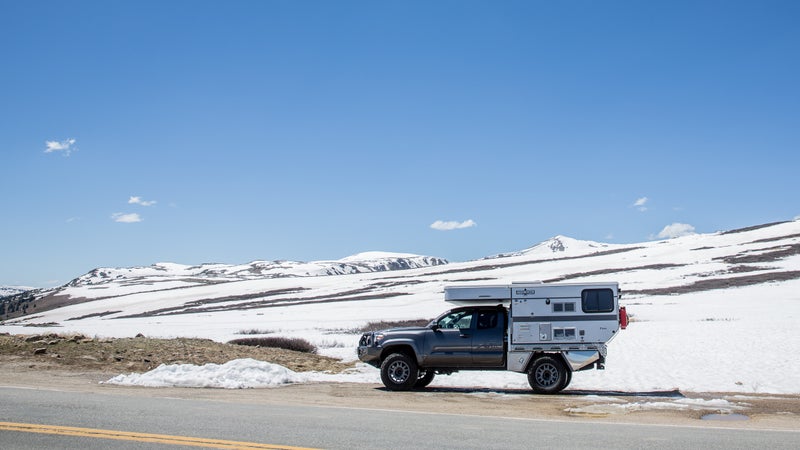
Buying Advice
Should you consider buying a Four-Wheel camper? If you own a Tacoma, don't even think about it until you're re-geared. If you own a��full-size truck, or a diesel truck, you have a better starting point.
You should also think about��how much and where you want to camp. If you're satisfied with camping in established sites that don't require an off-road vehicle, look elsewhere. Maybe consider a two-wheel-drive��van or just a regular rooftop tent.
If you do want to get away from the crowds, however, and you plan to camp a lot, these rugged pop-ups are��a great option.��They're convenient, bulletproof, and approaching affordable if you don't select the premium option. And unlike a van, which you can't really disassembled once it's built, a Four Wheel camper comes on and off your truck. That means you can use it when you want to camp, then take it off in the winter, and have your truck back as a daily driver��for the rest of the year.


